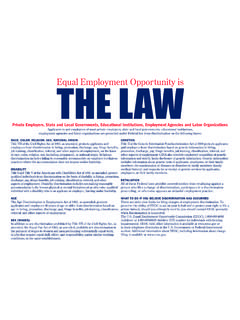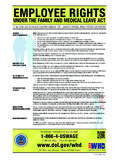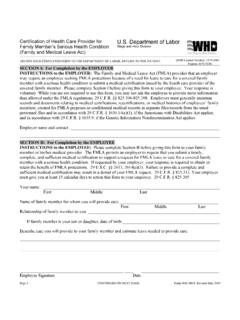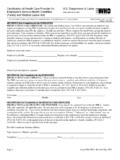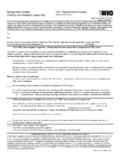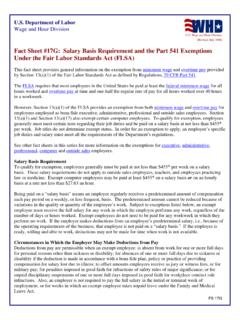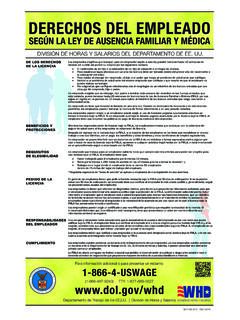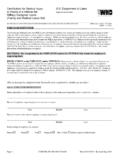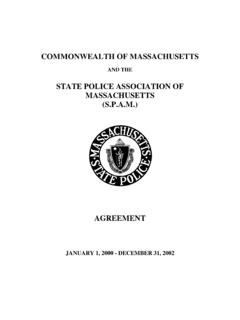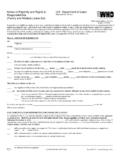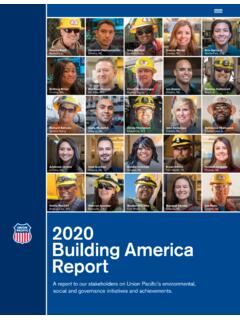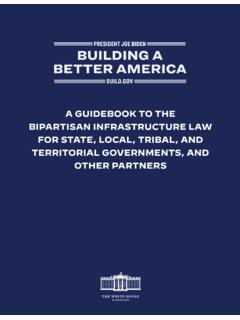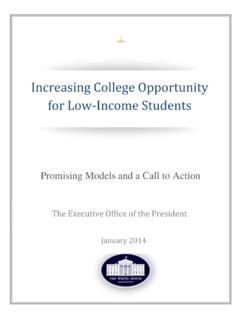Transcription of WIOA Works for America - DOL
1 June 2016 P a g e | 1 Our nation s workforce development system provides critical support and services to workers who want to develop the necessary skills for a good job and to employers who need skilled workers to compete. The enactment of the Workforce Innovation and opportunity Act (WIOA) by bipartisan majorities in Congress revitalized and transformed the public workforce system so that it reflects the realities of the 21st century economy and meets the needs of job-seekers, workers, and employers. The WIOA Final Rules include reforms that will affect more than a dozen programs receiving $10 billion in annual training and education funding and programs that serve approximately 20 million Americans each year. The Departments of Education and Labor, in close collaboration with the Departments of Health and Human Services, Agriculture, and Housing and Urban Development, have provided leadership in the implementation of WIOA.
2 The WIOA Final Rules, made publicly available on June 30, 2016, enable the workforce development system to more efficiently and effectively provide career pathways to Americans of all walks of life and a talented pool of workers for businesses of all sizes, which are vital to shared prosperity and a growing economy. Prior to the enactment of WIOA, individuals who needed job training or education often had difficulty navigating across agency lines to assemble an effective training and employment plan. The WIOA Final Rules improve coordination between and among agencies so that workers and job seekers have more seamless access to a system of high-quality career services, education, and training through the one-stop service delivery system, known as the American Job Centers, and partners.
3 The WIOA Final Rules also ensure the measurement and public reporting of the performance of education and training providers so that those seeking services can have access to provider performance information that will help them make informed choices about which training or education programs to pursue. Customers will also have information to better inform their choices when selecting training programs. Under the WIOA Final Rules, businesses will inform and guide the workforce system, ensuring that services are well aligned with their workforce needs. Workforce boards implement industry or sector partnerships and use high-quality worker training, including proven strategies such as apprenticeship, to ensure businesses have a pipeline of skilled workers. Additionally, under WIOA, the Administration will implement the performance measure geared specifically on how well the workforce development system is serving businesses.
4 Given the need to determine which performance measure will be most meaningful for assessing strong service to employers, the Joint Final Rule proposes a set of State pilots to test three different measures; including employee retention with the same employer, market penetration, and repeat business. Meeting workforce needs is critical to economic growth through partnerships at the State, regional, and local levels. WIOA promotes alignment of workforce development programs with regional economic development strategies to meet the needs of a wide range of employers and to enhance community development. WIOA also places a greater WIOA Works for America June 2016 P a g e | 2 emphasis on reemployment, requiring rapid response activity at the State level, including layoff aversion activities to help employers better manage reductions in force.
5 A key part of the WIOA vision is making government more efficient so that it more effectively serves the public through a comprehensive, integrated, and streamlined system. The WIOA Final Rules implement that vision by streamlining programs across Federal agencies, co-locating services at the State and local levels, requiring unified and integrated planning at the state level, providing for robust program evaluation, introducing strong common performance metrics to the system, and improving accountability and transparency, ensuring investments are evidence-based and data-driven. The WIOA Final Rules improve access to education and workforce services for individuals with significant barriers to employment some veterans, individuals with disabilities, out-of-school and at-risk youth, and other populations to help ensure that everyone has an opportunity to get a good job.
6 Performance measurement also will take into account differences in the populations served to remove any disincentives to serving those who need the most help. June 2016 P a g e | 1 The bipartisan Workforce Innovation and opportunity Act (WIOA) (Pub. L. 113-128), signed by President Obama on July 22, 2014, created a new vision for how America prepares an educated and skilled workforce that expands opportunity for workers and employers. WIOA represents the most significant reform to our public workforce development system in nearly 20 years. The same day the President signed WIOA into law, the Vice President released his Job-Driven Training report, recommending improvements to our Federal training programs, including stronger employer engagement, the use of work-based learning approaches like apprenticeship, accountability for employment outcomes, and regional partnerships.
7 The Administration laid out a vision for our job training system that as he explained trains our workers first based on what employers are telling us they re hiring for and helps business design the training programs so that we re creating a pipeline into jobs that are actually out there. Many of these recommendations complement the new law. The 21st century public workforce development system created through WIOA builds closer ties between business leaders, State and Local Workforce Development Boards, labor unions, community colleges, non-profit organizations, youth-serving organizations, and State and local officials to deliver a more job-driven approach to training and skills development. The system will deliver integrated, job-driven services to job seekers, including youth and those with barriers to employment, as well as to workers and employers.
8 It supports the development of strong regional economies and enhances performance accountability to better inform consumers and investors about programs and services that work. The WIOA Final Rules include reforms that will affect more than a dozen programs receiving approximately $10 billion in annual funding, and programs that serve approximately 20 million Americans each year, by: Ensuring Accountability for Employment Results. All programs will now report employment and earning outcomes, which is new for some programs, and all core programs will report on outcomes using the same definitions so that their results can more easily be compared. Improving Transparency for Job Seekers to Help Them Make Better Choices. Customers will also have information to better inform their choices when selecting training programs.
9 American workers looking to invest time and money in training can go online and see which programs have the best chance at giving them a leg up. Strengthening employer engagement and service to businesses. We are implementing a new accountability indicator to gauge how effectively businesses are served by the workforce system. The law also will increase opportunities for work-based learning, including on-the-job training and Registered Apprenticeships, for all Americans, particularly those with barriers to employment. Enhancing Coordination and Collaboration across Programs. We are implementing provisions of the law that require unified State planning across programs and co-location of more programs in American Job Centers. These reforms will result in streamlined access to customer-focused services and improved communication across the workforce system.
10 An Overview June 2016 P a g e | 2 Today, the Departments of Labor and Education (Departments) made available to the public a set of final regulations implementing WIOA. In developing these final regulations the Departments consulted with stakeholders, published proposed rules, and reviewed thousands of pages of public comments received in response to those proposed rules. The final regulations encourage customer-centered, job-driven strategies, such as career pathways, business engagement systems, sector strategies, and work-based learning; and they emphasize a commitment to high-quality services for all populations, including individuals with barriers to employment. These regulations provide the foundation upon which services to individuals and businesses can be strengthened and improved over time and include: Rule for Unified and Combined State Plans, Performance Accountability, and theOne-Stop System Joint Provisions.
